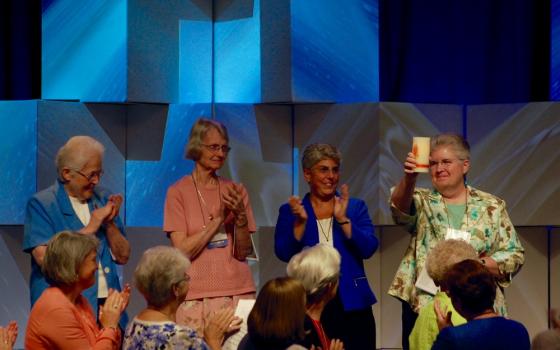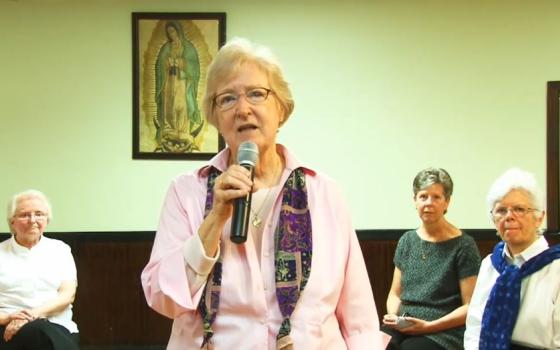When members of the Leadership Conference of Women Religious convene in Atlanta next week, they will discuss a familiar topic: the future of religious life. However, for the first time at an LCWR national assembly, contemplative dialogue will be the primary vehicle for this discussion.
Contemplative dialogue — a process through which people in a conversation intentionally set aside their biases in order to listen to others and to what others trigger emotionally in themselves — isn't new to LCWR or to Catholic sisters. Two years ago, the conference published an anthology on spiritual leadership that focused on prayerful and contemplative decision-making. Additionally, the group's communications director, Immaculate Heart of Mary Sr. Annmarie Sanders, said LCWR leadership has been engaging members in more contemplative practices for several years.
LCWR's 2016 assembly is Aug. 9-13; this year's theme is "Embracing the Mystery: Living Transformation." The two keynote addresses — from author Margaret Wheatley and former LCWR president Franciscan Sr. Pat Farrell — will focus on finding one's ground and leading from a place of mystery, respectively.
The Outstanding Leadership Award will be presented to Most Precious Blood Sr. Janice Bader, who stepped down after eight years as executive director of the National Religious Retirement Office in June after being elected president of her congregation.
LCWR's emphasis this year on contemplative dialogue is new, Sanders said, but it's also a natural evolution of the conference membership.
"When we first started doing these more contemplative practices a few years ago, people had to grow in their comfort level with it and see the power and the potential of engaging in this way with one another," she said.
It helped, Sanders added, that women religious were able to see how fruitful contemplative dialogue could be: LCWR leadership used it to engage with the Vatican during its controversial three-year oversight of LCWR that ended last year.
"Members want to gather in this kind of way," Sanders said. "It's become such a value — it's almost as if there is no other way right now," she added with a laugh.
There's no one way to "do" contemplative dialogue.
"I think one of the challenges is when we say 'contemplative dialogue,' it can mean different things for different people," said Connie Schoen, a Dominican Sister of Peace and associate director of the Centre for Contemplative Dialogue in southern Indiana.
But basically, Schoen said, the process is about suppressing the normal human inclination to stop listening during a conversation and to cling to what we already believe to be true.
Through practicing contemplative dialogue, she said, people can train themselves to be aware of that initial instinct and to open themselves to other possibilities: "How can I hold what I believe lightly in order to hear something that might reshape or open me to a different place of understanding?"
At this year's assembly, contemplative dialogue will take place in "deepening groups" of six sisters apiece that will follow each of the two keynote addresses. The women will be asked to come to their deepening group without any preplanned thoughts, and for 75 minutes, they will speak one at a time, each sister building only on what the last person has said.
In preparation for this activity, earlier this year, LCWR published to its website a one-hour video that models a similar contemplative dialogue session, facilitated by St. Joseph Sr. Liz Sweeney, a spiritual director from Wilmington, Delaware, who will be on hand at the assembly to offer reflections on what comes out of the deepening sessions. Members attending this year's assembly were asked to watch the video so they know what to expect in Atlanta.
"It's not the only way to do contemplative dialogue, but we think it's a good method for us in this assembly," Sanders said. "We're creating a deeper sense of what's emerging in the group. So it's not just that people are sharing their individual thoughts, but what's happening among the group and where's the movement of God among all of us."
It would be a mistake, however, to believe that contemplative dialogue is about groupthink, said Linda Haydock, a Sister of the Holy Names of Jesus and Mary and the executive director of Seattle's Intercommunity Peace & Justice Center, which teaches contemplative dialogue to faith communities.
Contemplative dialogue "doesn't mean that we can't come with a diversity of perspectives. In fact, it would be healthy to use this process with people who come from different perspectives," she said. "But we can't come with a set agenda. When we're listening for how the Spirit is working within the community, what's being called forth is new."
LCWR is one of a number of groups of women religious that engage contemplative dialogue to find communal discernment in a time of transition. For example, the Grey Nuns of the Sacred Heart in Yardley, Pennsylvania, hired Sweeney in 2013 to help work through the sale of their motherhouse and the subsequent relocation of almost 70 percent of their sisters to independent housing.
Sr. Mary Elizabeth Looby, a Grey Nun of that community, said contemplative dialogue softened what could have otherwise been a traumatic time in her congregation.
"It helps because people are able to honestly say, 'I'm still struggling with this, and I just need to know, how are you dealing with it?' " she said. "And we listen to each other about what's going on inside ourselves."
For Looby, the attraction women religious have to contemplative dialogue as a means of communication is due to their deep spirituality and the natural evolution of that spirituality.
"So much of spirituality has been kind of personal, and we realize we can't stay there," she said. "We have to realize that we're personal, but we're also part of a group. And there is a group reflection or a group image of who we're called to be."
Haydock agreed, noting that the old ways of breaking impasses in the social, cultural, political and ecclesial arenas have proven ineffective.
"The old solutions don't work anymore, and we're challenged to find new ways," she said. "This is something we can bring forward. Women religious have hundreds of years of rootedness in spirituality that guides who we are, what we do and how we do our mission. Women religious in North America, we have literally thousands of years — when we combine who we are — of wisdom in walking a spiritual path."
Sanders said newness is the hope at this year's LCWR assembly: that by being in tune to the movement of God in the group and not just the individual, something new will emerge regarding the future of religious life.
"Part of the nature of contemplative dialogue is that you don't know what's going to surface," she said. "But if you keep having the same conversations over and over and you go into a conversation already knowing what you're going to say, then usually, nothing new will happen."
"I think there's a belief that religious life is undergoing changing demographics for a reason, and that something new is evolving — we just don't quite know what it is yet," Sanders added. "We're hoping this practice will help stimulate the thinking of our members and help us see more clearly what it is that God's inviting us to at this time."
[Dawn Araujo-Hawkins is Global Sisters Report staff writer. Her email address is daraujo@ncronline.org. Follow her on Twitter: @dawn_cherie.]
Editor's note: An earlier version of this article stated the Grey Nuns of Yardley, Pennsylvania, were in Montreal.


